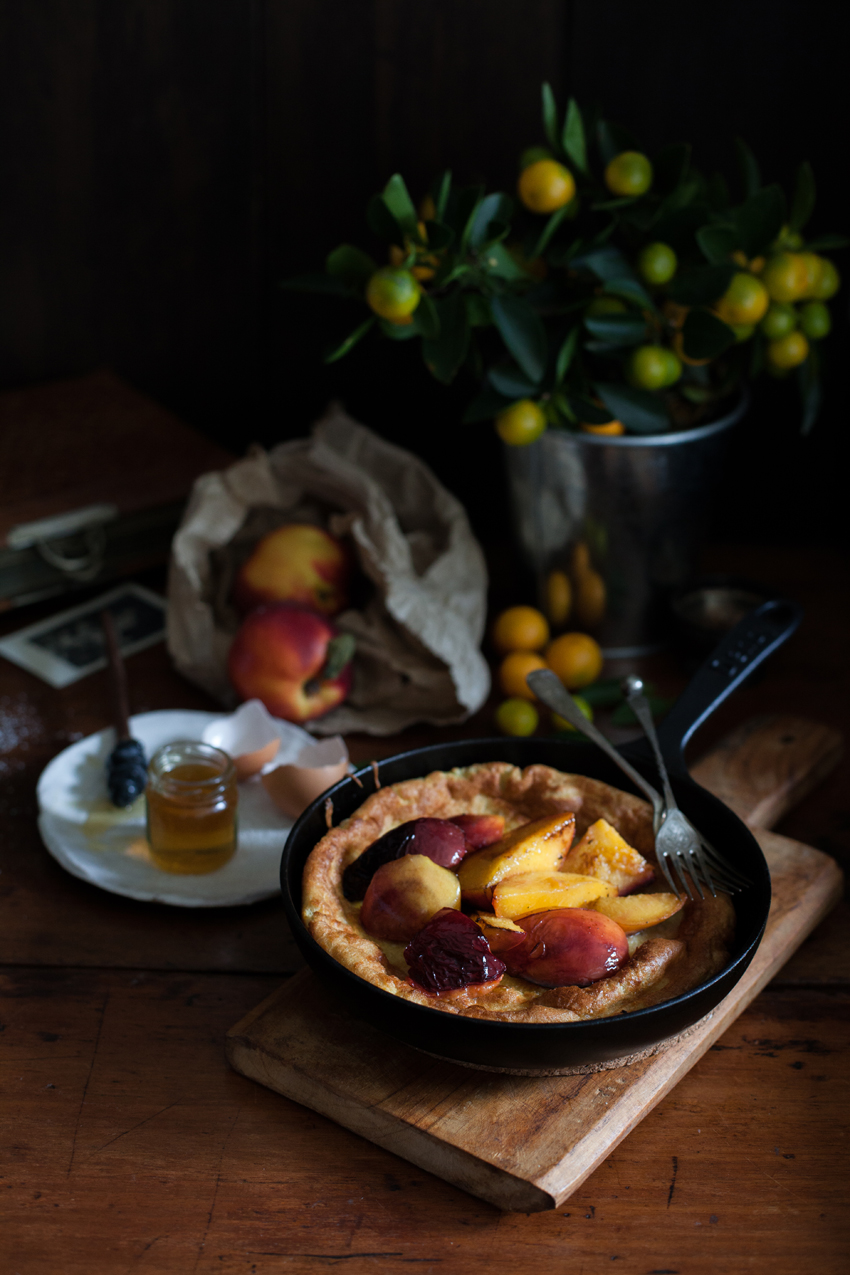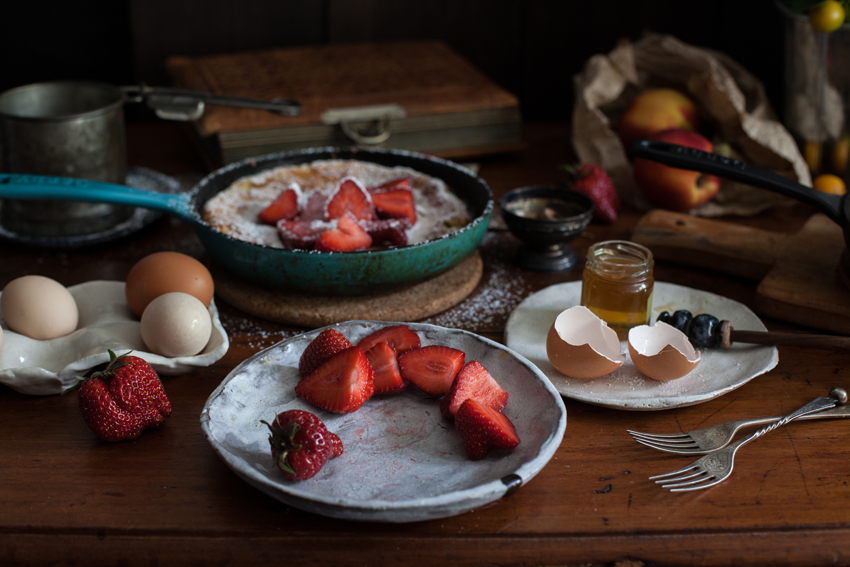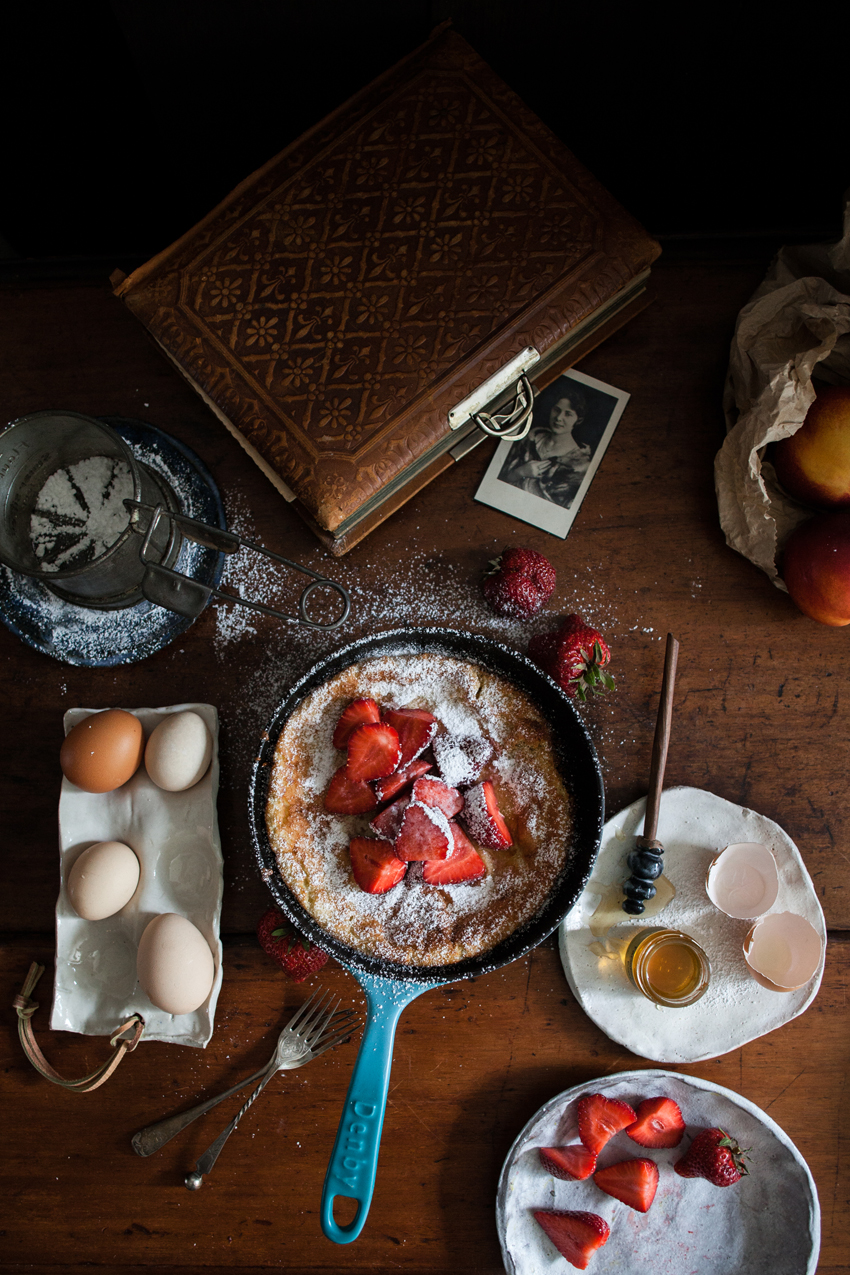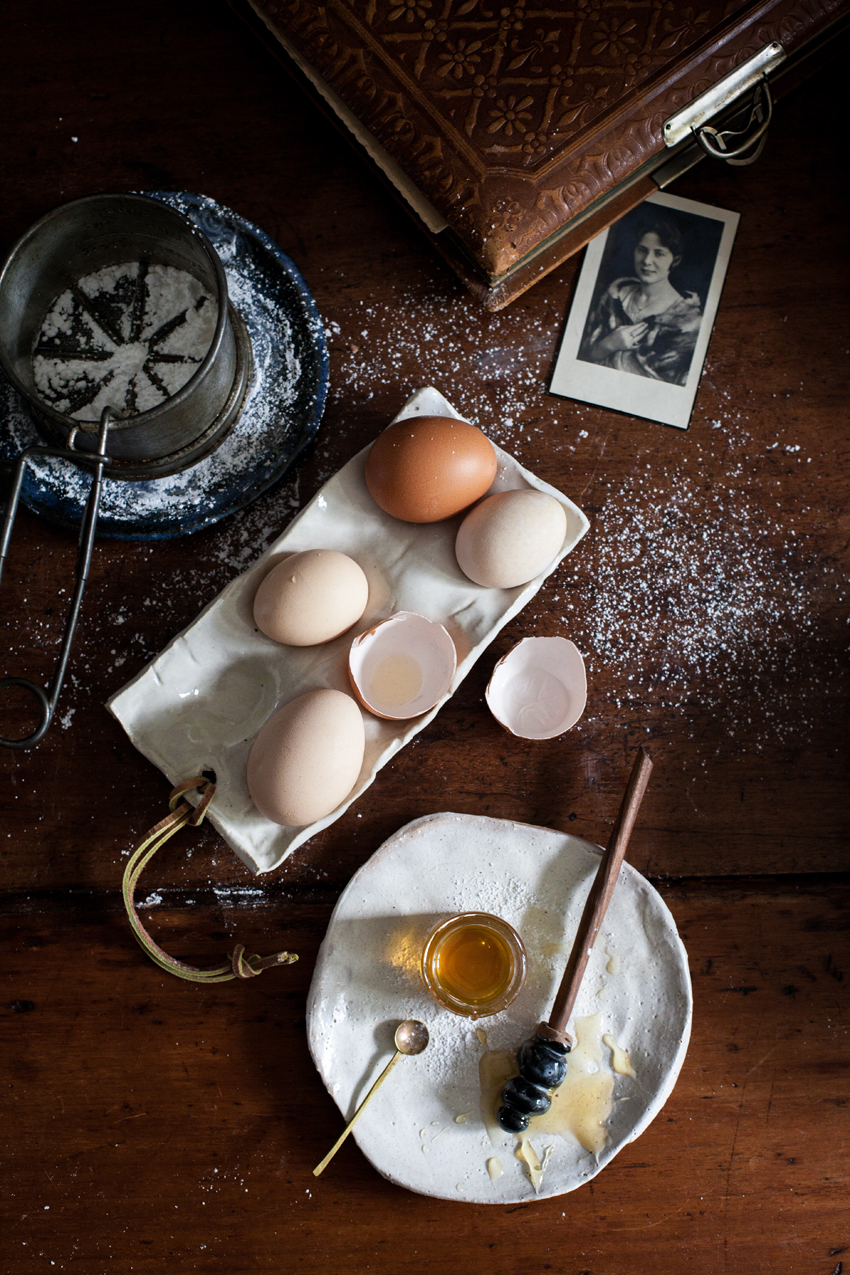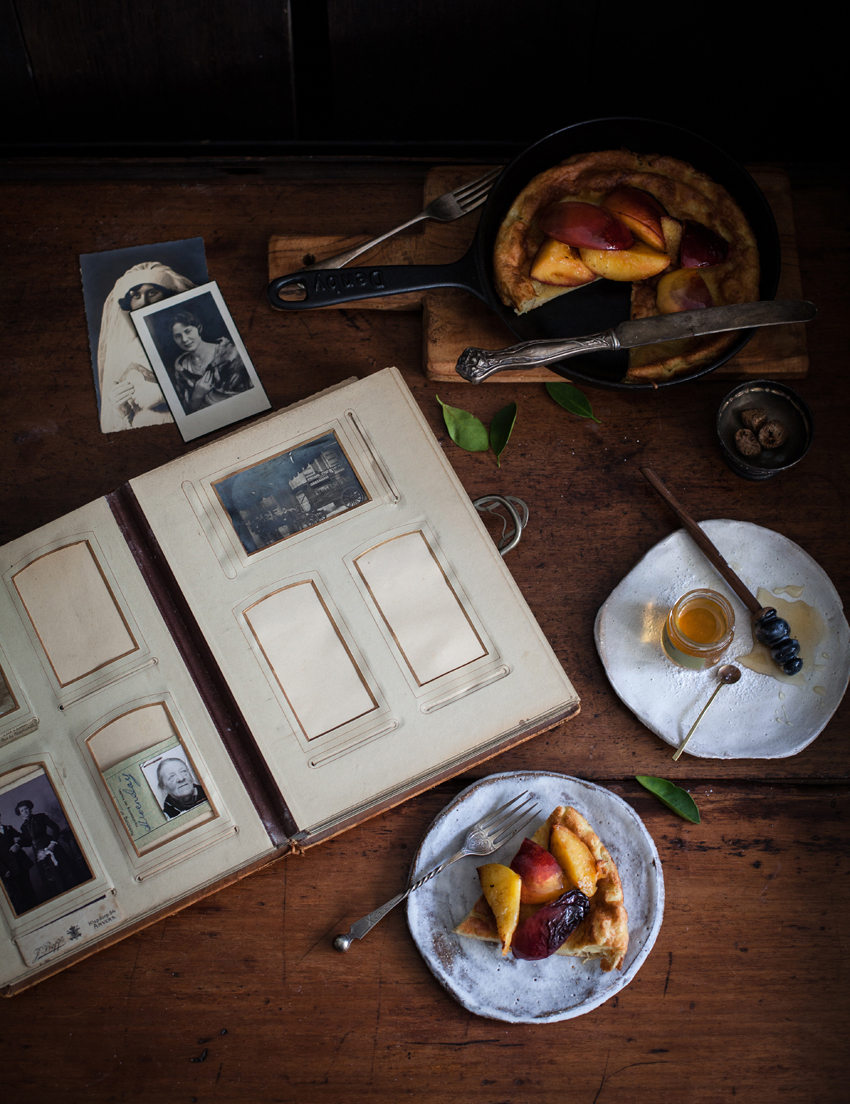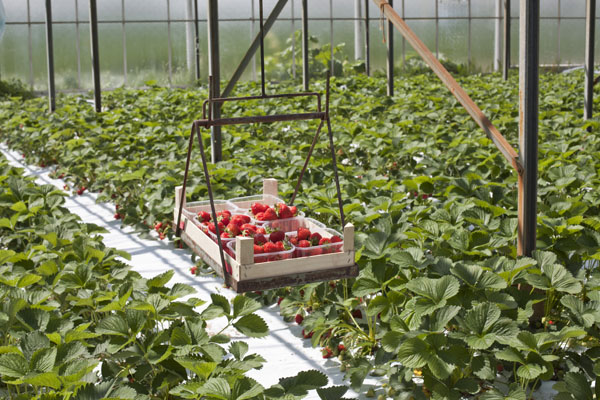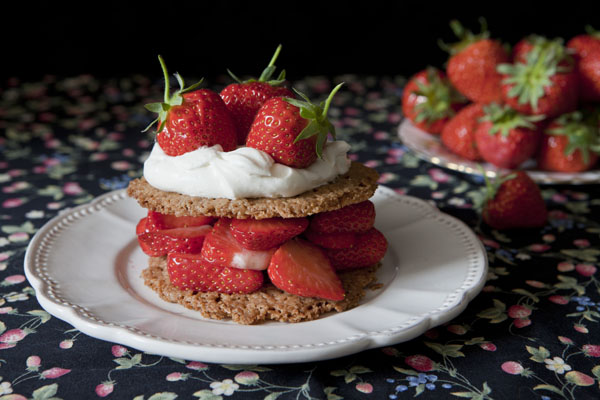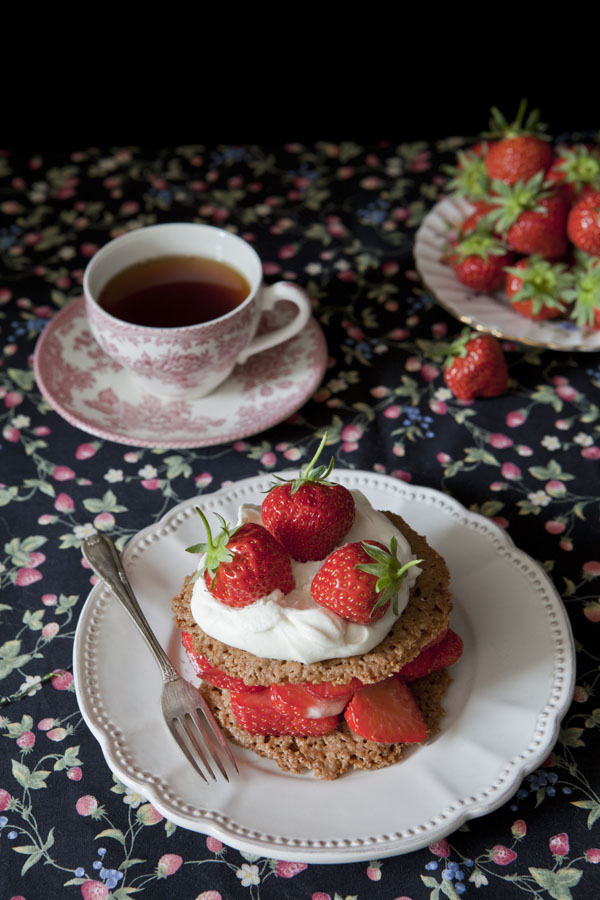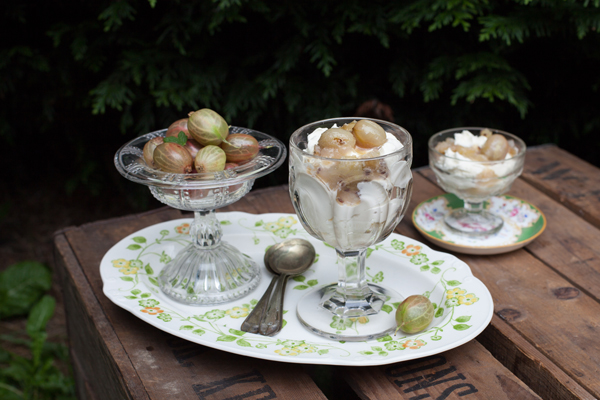The post Batter pudding, a Dutch baby and the scent of a ripening nectarine appeared first on Miss Foodwise.
]]>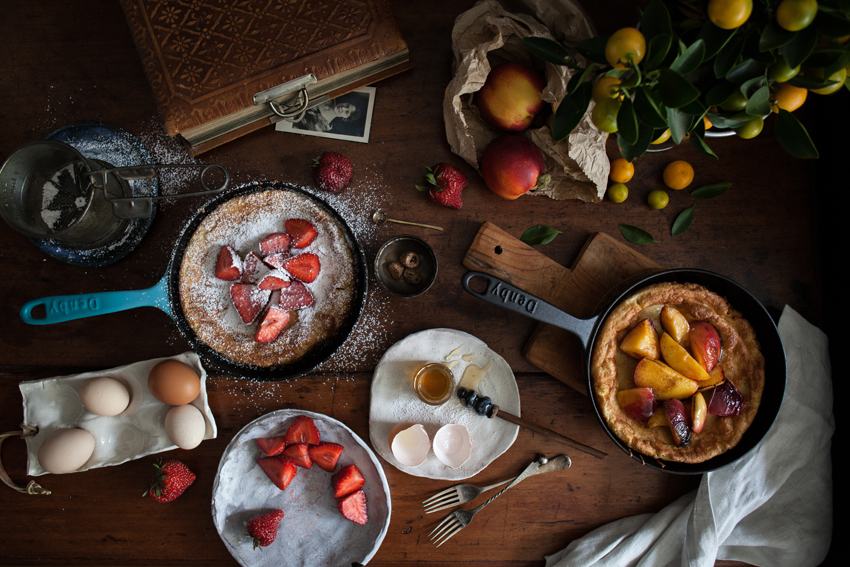 I can clearly remember the first time my brain registered the juiciness of a nectarine and its heavenly scent. It was summer and unusually hot. I was about 3 or 4 years old and me and my mother, the lady next door and her son Sam who had the same age, had walked quite a distance to a park where we could play. After we had played a while, Sam and I were each given an unusually large nectarine – mostly because our hands were very small. They came out of a brown paper bag, and I can still recall the sound of the bag, and the scent that came next when it was presented to me to pick my fruit. I remember that I smelled the skin of the fruit, looked at it, turned it around and was then handed a piece of white kitchen paper to catch the juice that was about to drip from my chin and hands. I investigated the skin between my fingers, the texture of the fruit. I recall the bitterness of the magenta red stone as I was trying to get the last of the flesh from it.
I can clearly remember the first time my brain registered the juiciness of a nectarine and its heavenly scent. It was summer and unusually hot. I was about 3 or 4 years old and me and my mother, the lady next door and her son Sam who had the same age, had walked quite a distance to a park where we could play. After we had played a while, Sam and I were each given an unusually large nectarine – mostly because our hands were very small. They came out of a brown paper bag, and I can still recall the sound of the bag, and the scent that came next when it was presented to me to pick my fruit. I remember that I smelled the skin of the fruit, looked at it, turned it around and was then handed a piece of white kitchen paper to catch the juice that was about to drip from my chin and hands. I investigated the skin between my fingers, the texture of the fruit. I recall the bitterness of the magenta red stone as I was trying to get the last of the flesh from it.
I had lost this memory for years because I had not encountered the scent of nectarines like that for a long time… I complained for the last decade that peaches and nectarines were harvested too early, that they never ripened, but rotted instead. They were as hard as a rock, cold from the fridges in which they were kept, like many people like them. They eat them like an apple, and enjoy the tangy unripe flavour. But this is not the way for me… You have to wait until the fruit gives off a heavenly scent as if it is a last breath. Only then, the fruit is ready to eat. Only then would the juices flow so rudely down from your chin and down into the collar of your dress or shirt.
I now feel like I have been given back something that I had lost, something I had forgotten that I had. Because saturday I opened a bag of unripe nectarines that I had forgotten about in my wicker shopping basket from the day before. It had been warm in our house, and the moment I opened the bag, there was that last bewitching breath of the nectarines… telling us they were ready to be devoured before they become so ripe that their skin only holds juice rather than flesh.
I feel blessed to have been given back a memory of my childhood with the scent of nectarines. This only goes to show how powerful the memory of taste and smell can be. Back came that summers day in the park, the tiredness from walking, the relief from hunger in the afternoon with the fruit, the long walk home in the sun… My little friend Sam who I was going to marry because he was going to be a fireman when he grew up, his mother, my mother. Back came the memory of dinner that night, my mums special Moussaka which isn’t a Moussaka at all. I recall being too tired to eat, nearly falling asleep in my plate of hot food, the window opened in our dining room, a breeze giving a well needed refreshment after possibly one of the warmest days of the year.
Something else was given to me in the last few weeks… a heavy leather photo album that contains photo’s of my ancestors. Up until that day I had never seen any old pictures of my fathers family. The album and a stack of other old pictures had been in the possession of my fathers sister who died over 10 years ago. Only recently when I was in a couple of magazines and newspapers with my book, my aunts daughter, my niece, contacted me. I hadn’t seen her for over 20 years, on my grandmothers funeral to be precise.
I now have an album with a couple of pictures, though it is mostly empty. I had never thought that the sight of old family could be so special. Most of us grow up with frames of pictures on walls and bedside tables, but I had none of my fathers side and few on my mothers side.
I first saw a picture of my dad when he was a boy, he was blonde like I was as a small child. He and a couple of other kids were playing in some field in Antwerp, most likely it is now a new neighbourhood. Then there were pictures of my dad when he was in his late twenties, on family gatherings with my mom. He wore flares and tight tee shirts as was the fashion in the 60’s. On other pictures he was filming and taking pictures, with my mom, niece and aunt around as well. I recognised myself in him, and the face I pull when I’m behind the camera. My dad decided to hold on to those pictures for a while but the oldest ones in the album, I took home. It is quite strange to have such a large album and have it nearly empty, but still it is a family heirloom I will cherish.
With the nectarines so lovely and fragrant I decided to bake batter puddings for tea. They are often referred to as Dutch babies, though they have nothing to do with the Dutch and are an American invention. Basically this is a Yorkshire pudding with a sweet topping. Something that has been eaten in England for a very long time. Leftover puddings from dinner would often be eaten as dessert – for pudding.
Theories on why it is called a Dutch baby are plenty, some say it comes from the Dutch ‘poffertjes’ but the method is different and the Dutch baby or batter pud tastes more like another batter pudding called ‘smoutebollen’ which are balls of dough deep fried in ‘smout’ which is tallow (animal fat) then dusted with icing sugar. But smoutebollen have a yeasted dough while the Dutch baby/batter pudding has a pancake dough.
The ‘Dutch’ could refer to the German-American immigrants known as the Pennsylvania Dutch, so ‘Dutch’ is in this case a corruption of the German autonym ‘deutsch’ (meaning German in German). If you want to know more about pancake-type history, I would recommend you read the whole story in ‘Pancake: a Global History’ by Ken Albala.
Batter puddings – or Dutch babies
What do you need (makes 2 batter puddings in 25 cm skillets, or 1 large one, or several small ones if using a muffin tray)
- 110 g plain flour
- a pinch of salt
- a teaspoon of vanilla sugar (optional)
- a pinch of nutmeg, or cinnamon if you prefer
- 280 ml milk (oatmilk or any other plant based milk works too)
- 3 large eggs
- sunflower oil, clarified butter, lard or tallow, for frying
Method
Proceed by creating the batter as you would for a pancake batter, adding the flour and pinch of salt to the milk and eggs, making sure there are no lumps. I find that the pudding improves if you leave the batter to rest for 30 minutes or so before cooking.
Preheat the oven to 250°C
Pour 1 cm of sunflower oil, clarified butter, lard or tallow into your cast iron skillets, or cake/muffin tin and set it in the middle of the hot oven. Place a larger tray underneath in case the fat drips: you don’t want extra cleaning and a smoky kitchen afterwards.
When the fat is hot (you will see it spitting): carefully but swiftly pour the batter into it and close the oven door.
Bake for 20–25 minutes without opening the oven until the pudding is puffed up and nicely coloured.
While the pudding is in the oven, you can prepare your fruit for the topping. Strawberries dusted with icing sugar and maybe some cream too is a definite winner. But roasted or baked nectarines or peaches make it into a more cosy pudding. Drizzle the fruit with some Grand Marnier in the pan for a grown up pudding. Roasted apples and pears with spices in winter and autumn, with maybe some blackberries added for colour. Cream or ice cream added to it is good for the soul.
If you are not into puddings that have warm fruit, or cold fruit on a warm pudding, the pud is just as good with a drizzle of honey, syrup (golden, date or whatever fancy syrup) or a simply dusting of icing sugar.
Eat hot.
You might also enjoy:
Cabinet Pudding from my book Pride and Pudding >
Kentish cherry batter pudding >
The post Batter pudding, a Dutch baby and the scent of a ripening nectarine appeared first on Miss Foodwise.
]]>The post Strawberry Spelt Shortcake, the history of Shortcake in Britain appeared first on Miss Foodwise.
]]>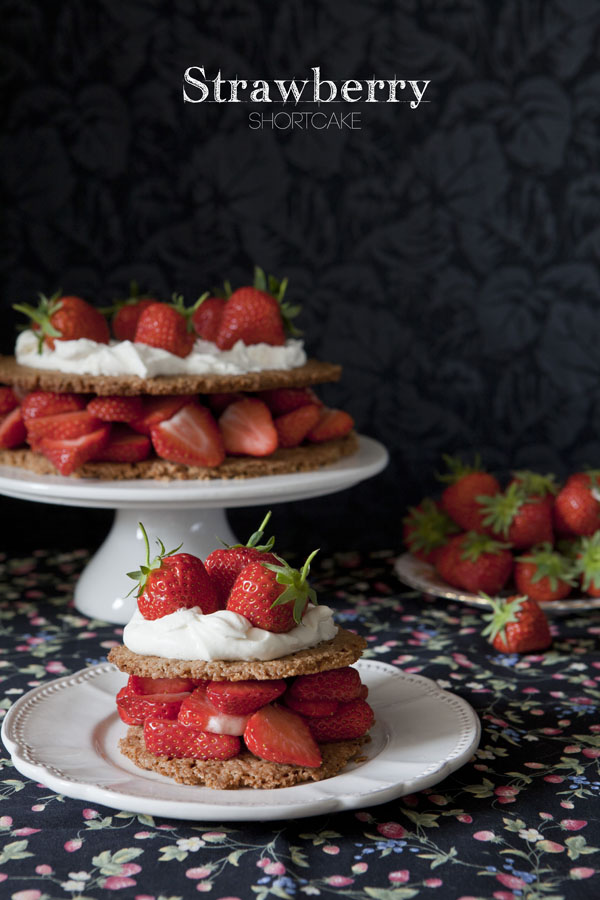
A Strawberry shortcake can take on many forms, it can be a scone-like cake, a sponge or a thin biscuit but two things remain the same throughout any recipe: fresh strawberries and lots of pretty whipped cream. Strawberries were first cultivated by the Romans in 200 BC but what about the origin of a Strawberry Shortcake?
In Medieval times newly-weds would be presented with a soup made of strawberries and sour cream topped with borage and sugar. They believed strawberries to be an aphrodisiac, yet no biscuit or cake of any kind accompanied the dish.
Short meaning crumbly from the Old English ‘cruma’ is a term that came to be in the 15th century, adding a large amount of fat or ‘shortening’ to flour results in a crumbly or ‘short’ texture.
In the Elizabethan cookbook The good Huswifes Handmaide
for the Kitchin. (1594 -1597) one can find the earliest record of the term ‘short cake’. Unfortunately none of the manuscripts that survived of this book are complete.
Take wheate flower, of the fayrest ye can get, and put it in an earthern pot, and stop it close, and set it in an Ouen and bake it, and when it is baken, it will be full of clods, and therefore ye must searse it through a search: the flower will haue as long baking as a pastie of Uenison. When you haue done this, take clowted Creame, or els sweet Butter, but Creame is better, then take Sugar, Cloues, Mace, and Saffron, and the yolke of an Egge for one doozen of Cakes one yolke is ynough: then put all these foresaid things together into the cream, & temper them al together, then put them to your flower and so make your Cakes, your paste wil be very short, therefore yee must make your Cakes very litle: when yee bake your cakes, yee must bake them vpon papers, after the drawing of a batch of bread.
A mention of a shortcake appears in one of Shakespeare’s plays ‘The Merry Wives of Windsor’ in 1602:
“Book of Riddles! why, did you not lend it to Alice Shortcake upon All-hallowmas last, a fortnight afore Michaelmas?”
After some research into these words and the help of some people who studied Shakespeare I found out that Alice was possibly the Countess of Derby who lived at that time and would have dispensed lard cakes referred to as short cakes to the poor. It is very possible that Shakespeare used Alice Shortcake as a nickname for Alice spencer the Countess of Derby but of course we are not entirely sure to say it is a fact.
What
fact is that the British have been enjoying Strawberry short cakes with
great pleasure for as long as anyone can remember and everyone seems to
have his or her own version of the dish. So here I shall bring you
mine, a ‘short’ thin wholemeal spelt biscuit that really lets the
strawberries and cream be the queen of the pudding.
This dish brings a bit of sunshine to your table, and dear oh dear do we need some sunshine is this dullest and coldest of springs.
I’m getting ready to travel to London for Food Blogger Connect, a conference where I will be one of the speakers this year. To those I will meet there, see you soon and to all the other lovely people, next time there will be yet another book from a friend on the blog!
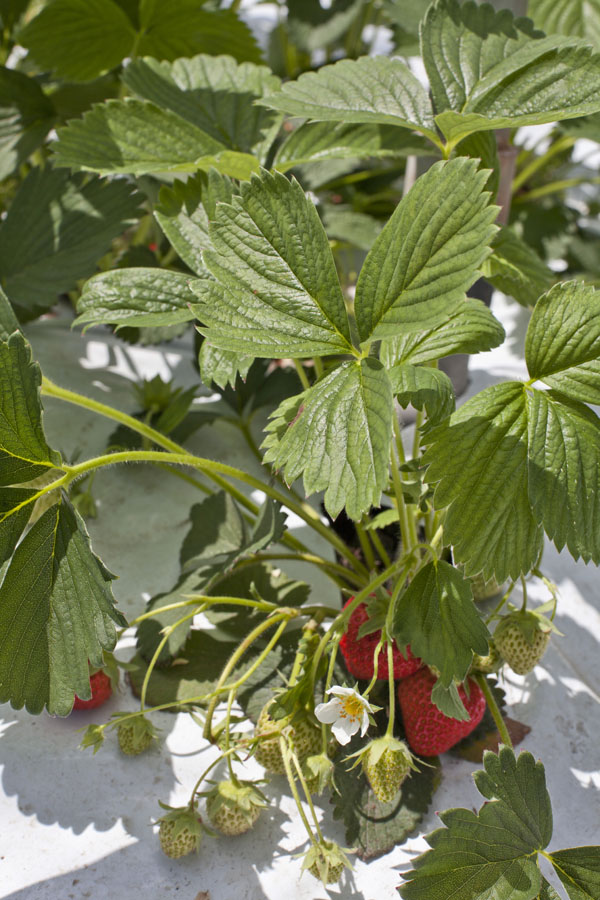 |
| from bloom to fruit |
 |
| My local strawberry farm |
Strawberry spelt shortcake
What do you need
Pastry
- 225 g cold butter
- 225 g wholemeal spelt flour
- 1 organic egg, beaten
- 100 g raw cane sugar
- vanilla, half a teaspoon
- salt, a pinch
For the filling and topping
- 300 – 500 g of strawberries, halved or quartered
- whipping cream 250 g
- 1 teaspoon of sugar to sweeten the cream
Method
- Place the butter and the flour in a bowl rub together until the mixture resembles breadcrumbs.
- Add sugar, salt and vanilla and work the dough until it comes together as a smooth pastry
- Roll out the dough until it is half a centimeter thick on a clean floured work surface
- Cut out circles of about 9 cm or two larger if you like to bake a large short cake
- Transfer the pastry circles onto greaseproof paper and chill for 30-50 minutes.
- Preheat your oven to 170° C
- Arrange the shortcakes on a baking tray – using the greaseproof paper to bake them on
- Put in the middle of the oven an bake for 20-25 minutes or until golden
- The mixture will spread while baking, don’t be alarmed by this, you can neaten the edges while warm.
- Transfer the cakes carefully to a wire rack to cool
- Cut your strawberries but leave some whole for decoration. Whip your cream.
- When the short cakes are completely cooled, arrange one shortcake on a plate or cake stand and cover it with the sliced strawberries, place another shortcake on top and top it with the whipped cream and the whole strawberries you saved for decoration.
- Serve straight away!
Note that some recipes require you to cut the strawberries, arrange them over your shortcake and let it sit for an hour before adding the top short cake and cream, I do not prefer to do so as the shortcake will get soggy and we won’t want a soggy bottom won’t we!
You might also like
apple and blackberry pie
Cornish splits
The post Strawberry Spelt Shortcake, the history of Shortcake in Britain appeared first on Miss Foodwise.
]]>The post Fool appeared first on Miss Foodwise.
]]>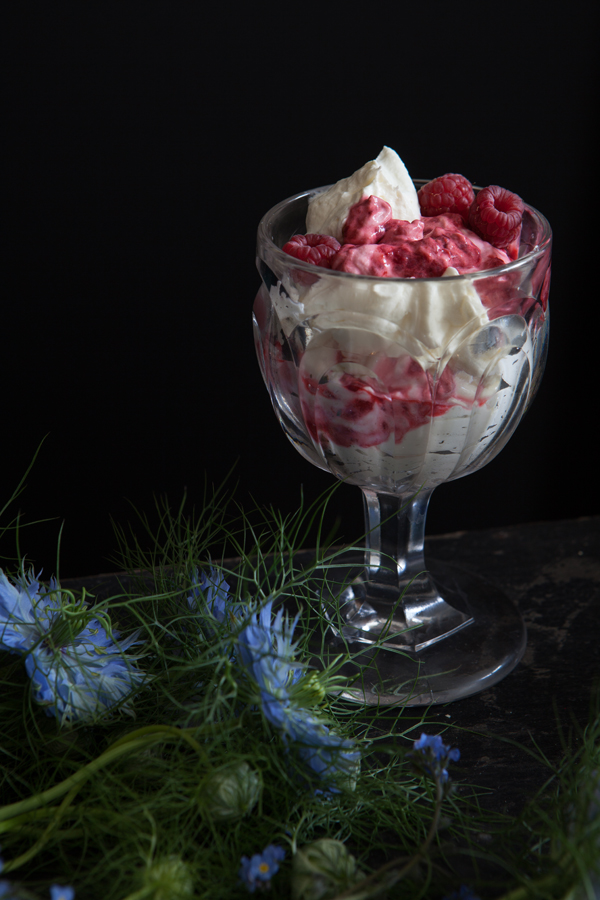
I started my second year in Culinary school this week. It’s going to be tough again combining this with my day job as a graphic designer. It always seems that the one day I can’t seem to get away from the office in time is the evening I have Culinary school to rush over to. I love the experience, the knowledge passed on to us by the chefs. I’m the student with the questions, the never ending enthusiasm, with the jokes and the loud giggles. Lessons always end with dinner, bottles of wine are opened and if we’re lucky a fellow student Jean, otherwise known as ‘the butcher’ has brought some of his home made port. We have a good time, have a laugh, a taste and a discussion about food. Our class is always the last to remain in the building and we leave the school grounds with rosy cheeks and a little bit pie-eyed.
A lot of modern recipes for Fruit Fools state the dish dates back as far as the 16th century. There is a recipe for Trifle in ‘The Good Huswifes Jewel’ by Thomas Dawson written in 1596. The recipe goes as follows:
Take a pint of thick cream, and season it with sugar and ginger, and
rose water. So stir it as you would then have it make it luke warm in a
dish on a chafing dish and coals. And after put it into a silver piece
or a bowl, and so serve it to the board.
Many historians including me have the theory that this early trifle recipe might have been where the Fool was born. However, this recipe does not contain any kind of fruit so maybe the first fool, wasn’t with fruit at all.
I have found a recipe for a ‘Gooseberry foole’ in ‘The Compleat Cook‘ by WM from 1658
Take your Gooseberries, and put them in a Silver or Earthen Pot, and set it in a Skillet of boyling Water, and when they are coddled enough strain them, then make them hot again, when they are scalding hot, beat them very well with a good piece of fresh butter, Rose-water and Sugar, and put in the yolke of two or three Eggs; you may put Rose-water into them, and so stir it altogether, and serve it to the Table when it is cold.
In this later recipe where indeed is spoken of a Fool there is no mention of cream, in fact many early Fool recipes use an egg mixture rather than just cream.
Gervase Markham as well as Robert May, have recipes for Norfolk Fools, they all have an egg mixture rather than cream. Does this mean Thomas Dawson’s recipe was actually an early Trifle after all?
Then I came across a recipe for a Strawberry or Raspberry Fool in ‘The Compleat Housewife: or Accomplished Gentlewoman’s Companion’ by Eliza Smith written in 1739. This appears to be one of the first recipes of a fool like we know it today. The fruit is squeezed and orange flower water is added, then cream.
Why the word ‘Fool’ is used is not entirely clear, some claim it’s derived from the French verb fouler which is used in the context of pressing grapes for wine with one’s feet.
For this Raspberry and Strawberry Fool I started out from a recipe dated 1823, I found in ‘Good things in England’ by Florence White. This is one of the recipes sent to White when she had called upon the people to send in their British family recipes.
The original recipes states you should pass the fruit trough a hair sieve but I didn’t as I think the interplay of textures is quite lovely.
You can use any fruit for this dessert but it works best with tart fruit, the most popular being gooseberries, however these should be stewed until they are soft enough.
What do you need (for 2)
a punnet of raspberries
a punnet of strawberries
(or another tart fruit like gooseberries which you stew first and then let cool)
500 ml double cream
1 teaspoon orange flower water (optional, used in traditional recipe)
1 teaspoon sugar (optional, used in traditional recipe)
Method
Divide your cream into two equal parts
Bruise 2/3 of the raspberries and all the strawberries with a fork, leave some bits in for texture, you can even add some whole raspberries at the end
Mix them with the orange flower water and sugar (optional, used in traditional recipe)
Stir one part of the cream in the fruit so you get a nice pink color
Now layer the plain cream with the fruit cream you created into the jars or glasses of your choice)
Decorate with some leftover fruits.
Enjoy!
* Why not substitute half of the cream with thick yoghurt for a lighter version of this dish!
Join me next time for some home made Raspberry Vinegar!
The post Fool appeared first on Miss Foodwise.
]]>